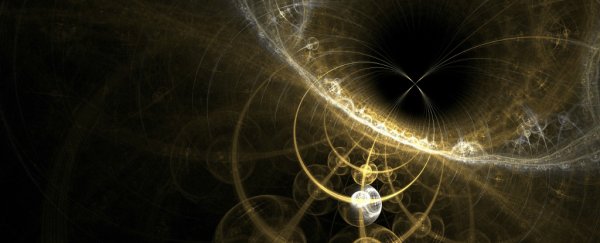Quantum communication is a strange beast, but one of the weirdest proposed forms of it is called counterfactual communication - a type of quantum communication where no particles travel between two recipients.
Theoretical physicists have long proposed that such a form of communication would be possible, but now, for the first time, researchers have been able to experimentally achieve it - transferring a black and white bitmap image from one location to another without sending any physical particles.
If that sounds a little too out-there for you, don't worry, this is quantum mechanics, after all. It's meant to be complicated. But once you break it down, counterfactual quantum communication actually isn't as bizarre as it sounds.
First up, let's talk about how this differs from regular quantum communication, also known as quantum teleportation, because isn't that also a form of particle-less information transfer?
Well, not quite. Regular quantum teleportation is based on the principle of entanglement - two particles that become inextricably linked so that whatever happens to one will automatically affect the other, no matter how far apart they are.
This is what Einstein referred to as "spooky action at a distance", and scientists have already used it to send messages over vast distances.
But that form of quantum teleportation still relies on particle transmission in some form or another. The two particles usually need to be together when they're entangled before being sent to the people on either end of the message (so, they start in one place, and need to be transmitted to another before communication can occur between them).
Alternatively, particles can be entangled at a distance, but it usually requires another particle, such as photons (particles of light), to travel between the two.
Direct counterfactual quantum communication on the other hands relies on something other than quantum entanglement. Instead, it uses a phenomenon called the quantum Zeno effect.
Very simply, the quantum Zeno effect occurs when an unstable quantum system is repeatedly measured.
In the quantum world, whenever you look at a system, or measure it, the system changes. And in this case, unstable particles can never decay while they're being measured (just like the proverbial watched kettle that will never boil), so the quantum Zeno effect creates a system that's effectively frozen with a very high probability.
If you want to delve a little deeper, the video below gives a great explanation:

Counterfactual quantum communication is based on this quantum Zeno effect, and is defined as the transfer of a quantum state from one site to another without any quantum or classical particle being transmitted between them.
This requires a quantum channel to run between two sites, which means there's always a small probability that a quantum particle will cross the channel. If that happens, the system is discarded and a new one is set up.
To set up such a complex system, researchers from the University of Science and Technology of China placed two single-photon detectors in the output ports of the last of an array of beam splitters.
Because of the quantum Zeno effect, the system is frozen in a certain state, so it's possible to predict which of the detectors would 'click' whenever photons passed through. A series of nested interferometers measure the state of the system to make sure it doesn't change.
It works based on the fact that, in the quantum world, all light particles can be fully described by wave functions, rather than as particles. So by embedding messages in light the researchers were able to transmit this message without ever directly sending a particle.
The team explains that the basic idea for this set up came from holography technology.
"In the 1940s, a new imaging technique - holography - was developed to record not only light intensity but also the phase of light," the researchers write in the journal Proceedings of the National Academy of Sciences.
"One may then pose the question: Can the phase of light itself be used for imaging? The answer is yes."
The basic idea is this - someone wants to send an image to Alice using only light (which acts as a wave, not a particle, in the quantum realm).
Alice transfers a single photon to the nested interferometer, where it can be detected by three single-photon detectors: D0, D1, and Df.
If D0 or D1 'click', Alice can conclude a logic result of one or zero. If Df clicks, the result is considered inconclusive.
As Christopher Packham explains for Phys.org:
"After the communication of all bits, the researchers were able to reassemble the image - a monochrome bitmap of a Chinese knot. Black pixels were defined as logic 0, while white pixels were defined as logic 1 …
In the experiment, the phase of light itself became the carrier of information, and the intensity of the light was irrelevant to the experiment."
Not only is this a big step forward for quantum communication, the team explains it's technology that could also be used for imaging sensitive ancient artefacts that couldn't survive direct light shined on them.
The results will now need to be verified by external researchers to make sure what the researchers saw was a true example of counterfactual quantum communication.
Either way, it's a pretty cool demonstration of just how bizarre and unexplored the quantum world is.
The research has been published in the journal Proceedings of the National Academy of Sciences.
